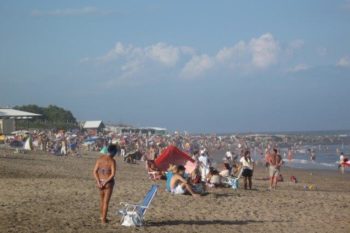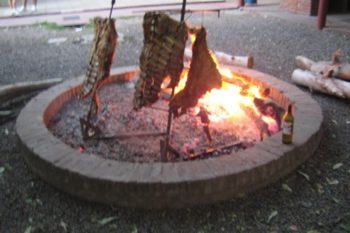My feet were killing me. My legs were practically devoid of feeling. Even my hip joints hurt. I was beyond tired but the thought of seeing the Basilica in all its glory kept me going. That, and a touch of pride too.
My group and I had joined tens of thousands of people from all walks of life in the biggest and most popular display of Christian faith in Argentina, the Peregrinación Juvenil -a 67 kilometre long trek from Buenos Aires to the sleepy town of Luján, home of the eponymous Basilica and the statue of Our Lady of Luján, the country’s patroness.
According to legend, in the 1630s a convoy of ox carts on their way north to Santiago del Estero stopped for the night in the area. They were carrying two terracotta statues of the Virgin Mary made in Brazil. The following morning they set off except for the cart carrying the statues. It didn’t move. The oxen pulled with all their might but the cart didn’t budge. They decided to try removing one of the statues to see what happened and the cart started to move slowly. Interpreting this as a miracle, that the Virgin Mary wanted to stay there, a local landowner built a shrine. With the passing of time, bigger constructions successively replaced that shrine until the current basilica was built in the late 1800s.
I was part of a group organized by my old school -a Catholic one at that, run by Dominican nuns- in October 1995. They gave us great support all the way through, they even brought us dinner.
The official starting point is the intersection of Avenida Rivadavia (which later becomes Route 7 and leads all the way to Luján) and Avenida General Paz in the neighbourhood of Liniers. Every year, one of the auxiliary bishops of Buenos Aires presides over Mass in the church of San Cayetano where he blesses the statue of Our Lady of Luján and sends her off, as it were, at the head of the procession (on the bed of a pickup truck). We decided to do a considerable shorter version and start in the city of Moreno, more or less half way, on Saturday evening.
Along the way, we passed by groups singing religious songs or praying the Rosary, priests giving their blessings, Red Cross nurses and doctors at roadside stalls –deployed every 500 metres- tending to blisters and other ailments, neighbours cheering us on. It was very touching to experience so much solidarity first hand.
However, I didn’t sing or pray. I cursed. A lot. I cursed the slower people that blocked my way. I cursed the maddening noise emanating from the boom boxes (it was cumbia, not psalms). I cursed people who littered. But mainly I cursed myself for agreeing to do this. Oh yes, I also cursed the boyfriend who had broken up with me and left me on the lurch with no plans for the weekend. In hindsight, this may not have been a very good reason to tackle such a feat of strength.
I managed not to drown in the waves of that human ocean –a record 1.3 million people is said to have taken part in 2009- and plodded on until we eventually reached the outskirts of Luján in the small hours of Sunday. Since there are very few tall buildings, the brightly lit spire can be seen from miles away. It’s a cruel visual trick played on exhausted pilgrims. You think you’ve made it but that elusive spire seems to recede with every step you take.
Inside the huge basilica, pews and floor were strewn with worn out pilgrims who sat down to pray or rest and fell instantly asleep.
There are countless reasons why people go on pilgrimages. To give thanks for favours granted; to make a petition; out of deep religious faith and conviction or as a result of a transaction made with God: you heal my child, I walk to Luján. The child is cured, the parent sets off. For most, it’s an intense religious and spiritual experience. Unfortunately, I missed out on that.
Many pilgrims renew their vows to the Virgin at the altar or make new ones. I solemnly vowed never to do this again.
So far, I’ve been true to my word.
Read more:
Tango: passion and nostalgia
Superstitions around the world
Blogs from Argentina on Blogs of the World









It was interesting to read this honest account of a pilgrimage.